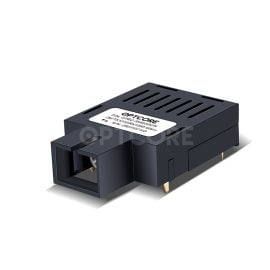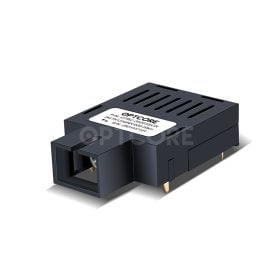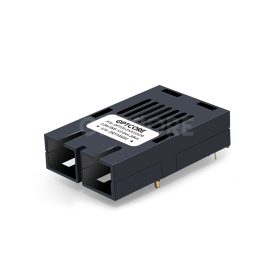Network Cabling
RS-232 vs RS-422 vs RS-485, What is the difference?
Initial Published: October 7, 2018, Updated: November 27, 2024
For many young people today, serial communication may be an outdated term. However, several of the most common standards, such as RS-232, RS-422, and RS-485, are still widely used in industrial communications. Therefore, we wrote this article to help beginners understand these standards and recognize the differences by comparing them in detail.
Now, let’s get started.
Table of Contents
- What is RS-232?
- What about the RS-232 features?
- What is RS-485?
- What about the RS422 features?
- RS422 vs RS-485
- What is RS-423?
- RS-232 vs RS-422 vs RS-485
- Controller Area Network
- Transistor-Transistor Logic
- FAQs
- Conclusion
What is RS232?
The RS-232 interface complies with the interface standard for serial data communication established by the Electronic Industries Alliance (EIA). The original number is EIA-RS-232 (232, RS232 for short). It is widely used for computer serial interface peripheral connections, connect cables, and mechanical, electrical, signal, and transfer processes.
The RS-232 standard specifies a data transmission rate of 50, 75, 100, 150, 300, 600, 1200, 2400, 4800, 9600, and 19200 baud per second.

What about the RS232 features?
RS-232 is one of the mainstream serial communication interfaces. Due to the early appearance of the RS232 interface standard, there are inevitably deficiencies, mainly the following four points:
#1: High interface signal level
The interface’s signal level is high, making it easy to damage the chip of the interface circuit. The voltage of any signal line on the RS232 interface is in a negative logic relationship.
The logic “1” is -3 – 15V; the logic is “0”: +3 – +15V, and the noise margin is 2V. The receiver must recognize a signal higher than +3V as a logic “0”, a signal lower than -3V as a logic “1”, a TTL level of 5V as a logic positive, and 0 as a logic negative. Incompatible with the TTL level, a level-shifting circuit is required to connect to the TTL circuit.
#2: Low transmission rate
The transmission rate is low. In asynchronous transmission, the bit rate is 20Kbps; therefore, the 51CPLD development board’s integrated program baud rate can only be 19200, which is also the reason.
#3: Weak noise immunity
The RS232 interface uses a signal line and a signal return string to form a common ground transmission form. This standard ground transmission is prone to common-mode interference, so the noise immunity is weak.
#4: Short transmission distance
The transmission distance is limited. The maximum distance is 50 feet, and it can only reach about 15 meters.
What is RS485?
The RS-485 serial bus is widely used when the communication distance must be several tens of meters to several kilometers. RS-485 uses balanced transmit and differential receives to reject common-mode interference.
In addition to the high sensitivity of the bus transceiver, it can detect voltages as low as 200mV, so it recovers the transmitted signal beyond the kilometer.
RS-485 uses a half-duplex mode of operation and sends only one point at any time. Therefore, the transmitting circuit must be controlled by an enabled signal.
What about the RS485 features?
RS-485 is very convenient for multi-point interconnection and can save many signal lines. Applications RS-485 can be networked to form a distributed system that connects up to 32 drives and 32 receivers in parallel. In response to the shortcomings of RS-232-C, the new standard RS-485 has the following features:
- Electrical characteristics of RS-485: The logic “1” is represented by the voltage difference between the two lines +2V~+6V, and the logic “0” is represented by the voltage difference between the two lines -6V~-2V. The interface signal level is lower than RS-232-C, and damaging the interface circuit chip is difficult. The level is compatible with the TTL level, which is convenient for connecting with the TTL circuit.
- The highest data transmission rate is: 10Mbps
- The RS-485 interface combines a balanced driver and a differential receiver, which has anti-common solid mode interference capability and good anti-noise performance.
- The maximum transmission distance of the RS-485 interface is 4000 feet, up to 3000 meters.
- The RS-232-C interface allows only one transceiver to be connected to the bus, i.e., single-station capability. In contrast, the RS-485 interface allows up to 128 transceivers to be connected on the bus, i.e., multi-station ability. The user’s device network can be quickly established using a single RS-485 interface.
What is RS422?
The full name of the RS-422 standard is “the electrical characteristics of the balanced voltage digital interface circuit,” which defines the characteristics of the interface circuit. There is a signal ground, a total of 5 lines.
Since the receiver uses high input impedance and the transmission driver has a more vital driving capability than RS232, it can connect multiple receiving nodes on the same transmission line, and up to 10 nodes can be connected.
There is one master device (Master), and the rest are slave devices (Slave). The slave devices cannot communicate with each other, so RS-422 supports point-to-multidirectional two-way communication. The receiver input impedance is 4k, so the maximum load capacity of the transmitter is 10 & TImes; 4k + 100Ω (terminating resistor).
What about the RS422 features?
Since the RS-422 four-wire interface uses separate transmit and receive channels, there is no need to control the data direction. Any necessary signal exchange between devices can be done in software mode (XON/XOFF handshake) or hardware mode (a pair of separate pairs). Stranded wire).
The RS-422 has a maximum transmission distance of 4000 feet (about 1219 meters) and a maximum transmission rate of 10 Mb/s.
The length of the balanced twisted pair is inversely proportional to the transmission rate, and it is possible to reach the maximum transmission distance below the 100 kb/s rate. The highest rate of transmission is only possible at very short distances. The maximum transmission rate on a typical 100-meter twisted pair is only 1 Mb/s.
RS-422 requires a terminating resistor with a resistance equal to approximately the characteristic impedance of the transmission cable. In short-distance transmission, the resistor is not needed. That is, generally, it is not needed below 300 meters. The terminating resistor is connected to the farthest end of the transmission cable.
RS422 vs RS-485, What is the difference?
The RS-422 and RS-485 circuits have the same principle. They are sent and received in differential mode; no digital ground is required. Differential operation is the fundamental reason for the long transmission distance under the same rate condition.
That is the real difference between the RS-422, RS-485, and RS232. Because RS232 is a single-ended input and output, at least digital ground is required for duplex operation. Send line and accept line three (asynchronous transmission). You can also add other control lines to complete synchronization and other functions.
RS-422 can work and receive with full-duplex operation through two twisted pairs. RS485 can only work half-duplex and cannot perform transmission and reception simultaneously, but it only needs one couple of twisted pairs. RS422 and RS485 can transmit 1200 meters at 19kpbs. A device can connect to the line on the new transceiver.
The electrical performance of RS-422 is the same as that of RS-485. The main difference is that RS-422 has four signal lines: two transmissions (Y, Z) and two receptions (A, B). Since the reception and transmission of RS-422 are separate, they can be simultaneously received and transmitted (full-duplex); RS-485 has two signal lines: transmission and reception.
What is RS423?
RS-423, or RS/EIA/TIA-423, is a standard for serial communications with enhanced features superior to RS232. It defines an unbalanced (single-ended) interface, similar to RS-232, with a single, unidirectional transmit driver, allowing up to 10 receivers. It is typically implemented with integrated circuit technology and for serial binary signal exchange between DTE and DCE.
RS-422 supports multipoint connections, while RS-423 supports only point-to-point links. RS-422 is designed for the direct connection of smart devices. In contrast, RS-423 is designed to augment RS-232 and act as an intermediary between RS-422 and RS-232.
RS-423 and RS-232 have all the disadvantages of devices using common ground, which can degrade device communications and may lead to potential communication failures, the cause of which is often undetermined.
In this regard, RS-422, RS-485, and Ethernet over twisted pair connections are superior. RS-423 is unpopular in the industry because of its shortcomings.
What is the difference between RS-232 vs RS-422 vs RS-485?

- RS232 is full-duplex, RS485 is half-duplex, and RS422 is full-duplex.
- RS485 and RS232 are the only physical communication protocols (i.e., interface standard); RS485 is the differential transmission mode, and RS232 is the single-ended transmission mode. Still, the communication program does not have much difference.
The PC is already equipped with RS232, which can be used directly. If RS485 communication is used, it is only necessary to connect an RS232 to an RS485 conversion head on the RS232 port, and there is no need to modify the program.
Is there a difference in the appearance of the RS232/RS422/RS485 interface?
Generally, it is DB9; there are others, or you have to look at the inside line to know which one is rs232/rs422/rs485.
RS232 is a standard interface, which is a D-shaped 9-pin. The signal definition of the interface of the connected device is the same. The signal is defined as follows:

RS-232 only allows one-to-one communication (single station capability)

The RS-485 interface provides up to 128 transceivers on the bus (with multi-station capability)

Since the default of the PC only has the RS232 interface, there are two ways to get the RS485 circuit of the PC host computer:
(1) Convert RS232 signal of PC serial port into RS485 signal through RS232/RS485 conversion circuit. An anti-surge with isolation product is best for an industrial environment with a complicated situation.
(2) the output signal can be directly selected as an RS485-type expansion card through the PCI multi-port serial card.
The computer connects multiple 485 devices (access controllers) through the RS232-RS485 converter and pollutes the devices on the bus.
The wiring label is 485+485-, corresponding to 485+485- of the link device (controller).
1. Communication distance
The distance between the farthest device (controller) and the computer is theoretically 1200 meters. We recommend that the customer control is within 800 meters and the best control is within 300 meters.
If the distance is too long, you can purchase 485 repeaters (extension) (please buy it from a professional converter manufacturer, where the repeater is placed in the middle of the bus or at the beginning, please refer to the manufacturer’s manual.) The repeater can theoretically be extended to 3000 meters.
2. The number of loads
How many devices (controllers) can a 485 bus carry? That depends on selecting the communication chip of the controller and the communication chip of the 485 converters.
Generally, there are 32, 64, 128, and 256. This kind of choice is the theoretical number. In actual application, according to the scene environment, communication distance, and other factors, the number of loads does not reach the number of indicators. The micro-farming company controller and converter are designed in 256 units, and the customer is recommended to control each bus within 80 units.
485 communication bus (must twisted pair or one of the network cables). If you use ordinary wires (no twist), the interference will be massive, communication will not be smooth, and even communication will be impossible.
Each controller device must be hand-in-hand, with no star connection or fork. If there is a star connection or a fork, the interference will be substantial, the communication will be poor, and even the transmission will not be possible.
RS-232 vs RS-422 vs RS423 vs RS-485, Complete Comparison
| Specifications | RS-232 | RS-423 | RS-422 | RS-485 | |
| Mode of Operation | Single -Ended | Single -Ended | Differential | Differential | |
| Total Number of Drivers and Receivers on One Line | 1 Driver 1 Recvr | 1 Driver 10 Recvr | 1 Driver 10 Recvr | 1 Driver 32 Recvr | |
| Maximum Cable Length | 50 ft. | 4000 ft. | 4000 ft. | 4000 ft. | |
| Maximum Data Rate | 460kb/s | 100kb/s | 10Mb/s | 30Mb/s | |
| Maximum Driver Output Voltage | +/-25V | +/-6V | -0.25V to +6V | -7V to +12V | |
| Driver Output Signal Level (Loaded Min.) | Loaded | +/-5V to +/-15V | +/-3.6V | +/-2.0V | +/-1.5V |
| Driver Output Signal Level (Unloaded Max) | Unloaded | +/-25V | +/-6V | +/-6V | +/-6V |
| Driver Load Impedance (Ohms) | 3k to 7k | >=450 | 100 | 54 | |
| Max. Driver Current in High Z State | Power On | N/A | N/A | N/A | +/-100uA |
| Max. Driver Current in High Z State | Power Off | +/-6mA @ +/-2v | +/-100uA | +/-100uA | +/-100uA |
| Slew Rate (Max.) | 30V/uS | Adjustable | N/A | N/A | |
| Receiver Input Voltage Range | +/-15V | +/-12V | -10V to +10V | -7V to +12V | |
| Receiver Input Sensitivity | +/-3V | +/-200mV | +/-200mV | +/-200mV | |
| Receiver Input Resistance (Ohms) | 3k to 7k | 4k min. | 4k min. | >=12k | |
Controller Area Network (CAN)
CAN is an in-vehicle network communication protocol introduced by Bosch in the 1980s, widely used in automotive and industrial control applications. The protocol’s main features include:
- Electrical characteristics: CAN also uses differential signaling, logic “implicit” (logic “1”) state when the two lines (CAN_H and CAN_L) voltage difference is about 2V, logic “explicit The voltage difference between the two lines (CAN_H and CAN_L) is about 2V in the “logic” (logic “1”) state, while the voltage difference in the “logic” (logic “0”) state is almost 0V.
- Communication mode: It supports multi-point communication with a multi-master-slave structure, adopts an arbitration mechanism to deal with bus conflict, and supports two modes of high speed (CAN High Speed) and low speed (CAN Low Speed).
- Transmission distance: Under the correct wiring conditions, the transmission distance of a CAN bus can reach 10 kilometers (High-Speed CAN) or several kilometers (Low-Speed CAN).
- Applications: Mainly used in vehicle electronic systems and industrial automation control systems.
Transistor-Transistor Logic (TTL)
TTL refers to a logic-level standard commonly used for communication within or between closely situated integrated circuits rather than a communication standard. The primary characteristics of this standard include:
- Electrical characteristics: TTL level signals are usually defined as logic “1” at about +5V (typical) and logic “0” at close to 0V, with relatively small signal amplitude.
- Communication Mode: TTL level is mainly used for chip-level interfaces, such as UART, SPI, I²C, and other signal-transmission interfaces.
- Transmission distance: Due to the faster signal attenuation of TTL level, it is unsuitable for long-distance transmission, generally within a few centimeters to a few meters.
- Applications: TTL level is widespread in the internal communication of embedded systems, between integrated circuits on computer motherboards
Explore our 1×9 optical transceivers for industrial control.
Frequent ask questions (FAQs)
What is UART?
UART stands for Universal Asynchronous Receiver-Transmitter. It is a serial port technology used to implement serial data transmission. It is a circuit responsible for converting parallel data to serial data for communication and serial data back to similar data for use by the receiver.
How do we eliminate common mode interference on the RS-485 bus?
These methods usually eliminate common mode interference:
- Use of shielded twisted-pair cables and adequate grounding
- Consider galvanized pipe shielding where strong electric fields are present.
- Wiring away from high-voltage lines, not to mention high-voltage power lines and signal lines bundled together in the line
- Do not share the same power supply with the electronic control locks
- (Use linear regulated power supply or high-quality switching power supply (ripple interference less than 50mV)
Conclusion
RS232, RS422, RS423, and RS485 are all essentially physical layer protocols. They are all serial communication protocols and are ubiquitous device interfaces. Serial interfaces are widely used in electronics and embedded systems, often for remote acquisition of device data or remote control.
They change how the signal is transmitted, whether to a PC, microcontroller, or serial communication using serial communication protocols or TTL-level transmission. A communication converter chip must convert them to RS232, RS422, RS423, or RS485 signals.
Learn more about TTL 1×9 transceiver suitable for RS232, RS422, and RS485 industrial Ethernet.
Reference:
- http://www.elecfans.com/emb/jiekou/20180418663969.html
- http://www.rs485.com/rs485spec.html
- https://www.linkedin.com/pulse/eia-rs-485-rs-423-rs-422-rs-232-vinay-sahu
Read more:
- HBA detailed explanation, how much you know?
- 25G Ethernet VS 40G Ethernet, which is Right for You?
- What is 1×9 Transceiver? The Definitive Guide

 Español
Español 日本語
日本語 Français
Français












Typo:
RS-422 can work and receive without full-duplex operation through two pairs of twisted pairs.
Should read:
RS-422 can work and receive with full-duplex operation through two pairs of twisted pairs.
Thank you for the suggestion, we will update the article.
Typo:
RS-422 can work and receive without full-duplex operation through two pairs of twisted pairs.
Should read:
RS-422 can work and receive with full-duplex operation through two pairs of twisted pairs.
it may be easier to use an rs232 to rs485 converter that sits outside the pc. Make sure that the converter has intelligent control of the transmitters so that it will automatically take care of the switching for you and will be transparent to the user. Then, program the device as you would an rs422 or rs232 device. One such device is our model cat-285.
Thanking you for educating us about RS 232/485/422 COMMUNICATION.
Are these comm. modules are used in OSI/TCP/IP PROTOCOL.
PL.REPLY
Thanks a lot.I learned so much.
There is lot of difference between them. All of them are used for different purpose and should not be combined